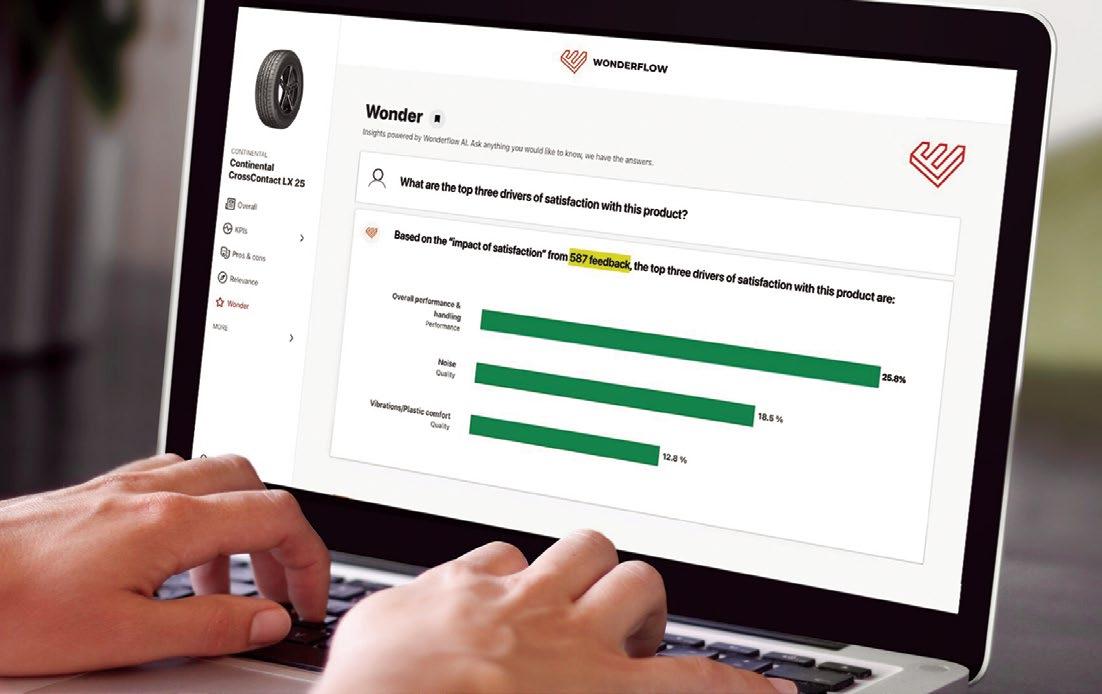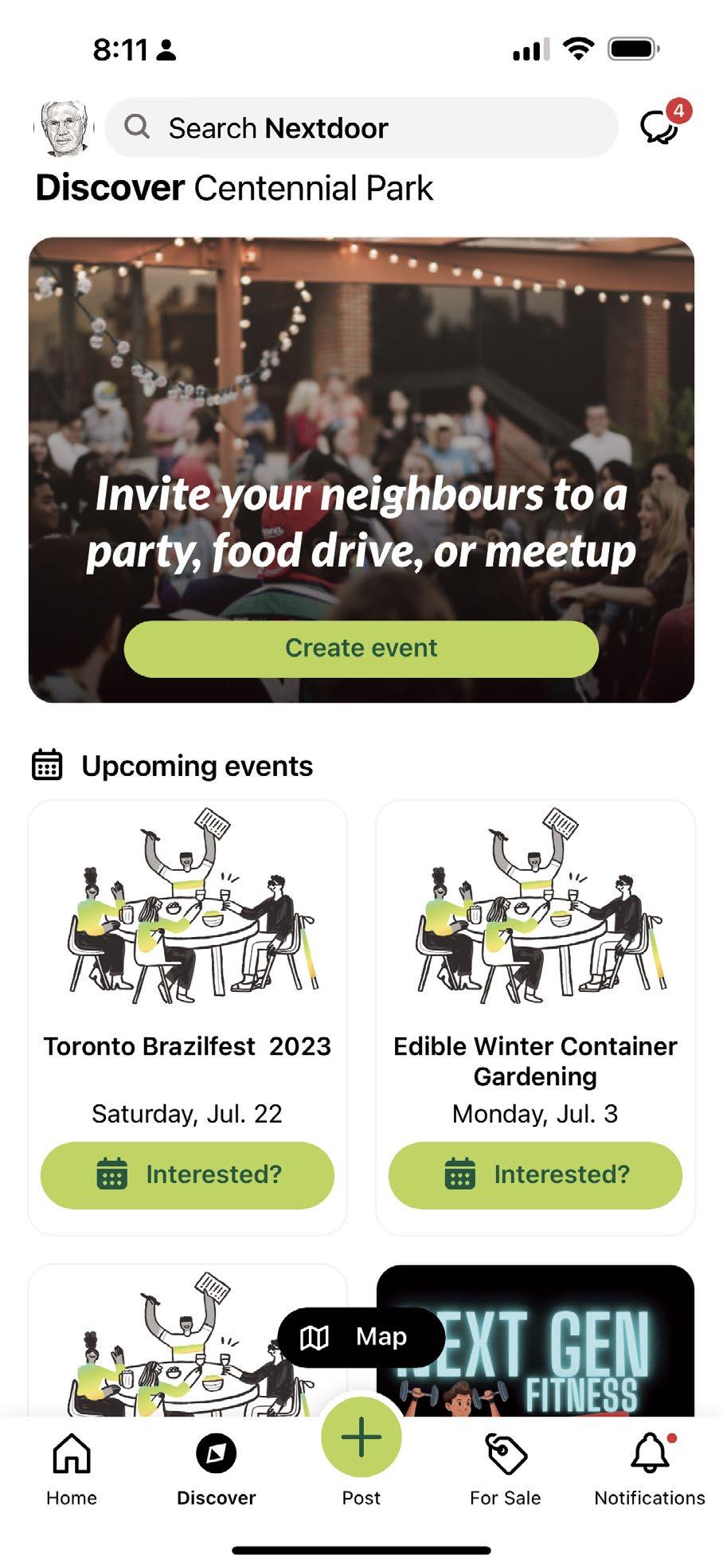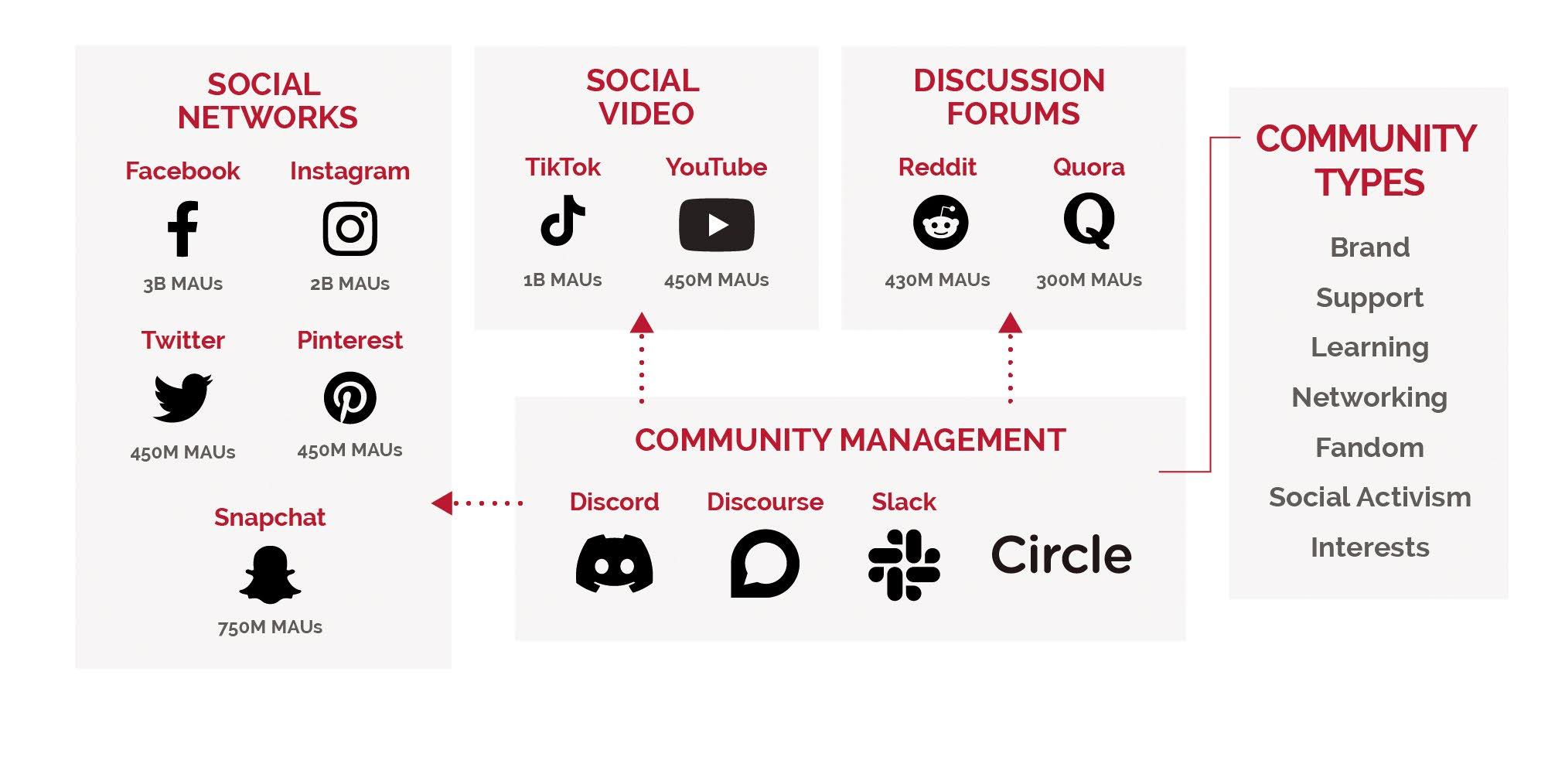Being data-driven is complicated. We can help.



VOL. 36 • NO. 7 • JULY 2023 THE AUTHORITY FOR THE DATA-DRIVEN BUSINESS PM40050803 ❱ 6 Pricing Fundamental To Acquisition & Retention ❱ 16 Disruption Comes to Funeral Services THE SOCIAL BRAND Inside a New Marketing Era ISTOCK/ HOCUS-FOCUS
We’ll Help You Keep It Clean
Dealing with bad data is a task no marketer needs on their checklist. Inaccurate, outdated, and duplicate records can build up in your database, affecting business decisions, the customer experience, and your bottom line. As the Address Experts, Melissa helps our customers improve their direct marketing efforts with the best Address Veri cation, Identity Veri cation and Data Enrichment solutions available. We validated 30 billion records last year alone, which is why thousands of businesses worldwide have trusted us with their data quality needs for 37+ years.
BAD DATA BUILDUP
Returned Mail & Packages
Missed Opportunities
Decreased Customer Insight
DATA CLEANLINESS
Real-time Address Veri cation
Change of Address/NCOA Processing
Geographic & Demographic Data Appends
Contact us for a Free Proof of Concept and ask about our 120-day ROI Guarantee.
Trust the Address Experts to deliver high-quality address veri cation, identity resolution, and data hygiene solutions.

Melissa.com 800.MELISSA (635-4772)
Vol. 36 | No. 7 | July 2023
PRESIDENT Publisher & Editor-in-Chief
Steve Lloyd - steve@dmn.ca
ASSOCIATE EDITOR
Michael Brooke - michael@lloydmedia.ca
DESIGN / PRODUCTION
Jennifer O’Neill - jennifer@dmn.ca
ADVERTISING SALES


Steve Lloyd - steve@dmn.ca
CONTRIBUTING WRITERS

Paula Attfield
Michael Brooke
Greg Demas
Stephen Shaw
LLOYDMEDIA INC.
HEAD OFFICE / SUBSCRIPTIONS / PRODUCTION:
302-137 Main Street North
Markham ON L3P 1Y2
Phone: 905.201.6600
























Fax: 905.201.6601 • Toll-free: 800.668.1838 home@dmn.ca • www.dmn.ca
EDITORIAL CONTACT:
DM Magazine is published monthly by Lloydmedia Inc. DM Magazine may be obtained through paid subscription. Rates:
Canada 1 year (12 issues $48)
2 years (24 issues $70)
U.S. 1 year (12 issues $60)
2 years (24 issues $100)
DM Magazine is an independently-produced publication not affiliated in any way with any association or organized group nor with any publication produced either in Canada or the United States. Unsolicited manuscripts are welcome. However unused manuscripts will not be returned unless accompanied by sufficient postage. Occasionally DM Magazine provides its subscriber mailing list to other companies whose product or service may be of value to readers. If you do not want to receive information this way simply send your subscriber mailing label with this notice to: Lloydmedia Inc. 302-137 Main Street North Markham ON
POSTMASTER:
// 3 JULY 2023 DMN.CA ❰
L3P 1Y2 Canada.
Please send all address changes and return all undeliverable copies to: Lloydmedia Inc. 302-137 Main Street North Markham ON L3P 1Y2 Canada Canada Post Canadian Publications Mail Sales Product Agreement No. 40050803 Twitter: @DMNewsCanada NEXT ISSUE: Inside Fulfillment, Shipping & Delivery ❯ 4 Talking Points talkingpoints ANALYTICS ❯ 6 Why Customer-Centric Pricing Is Fundamental to Acquisition and Retention ❯ 14 Disruption and Transformation in the Funeral Services Industry ❯ 18 Why Nonprofits Should Learn from Corporate Sector’s Data-Driven Strategy ❯ 7 The Social Brand Inside a New Marketing Era ISTOCK/ IRINA SHATILOVA INSIGHTS ISTOCK/ HOCUS-FOCUS VECTEEZY.COM ISTOCK/ HOWLETTERY
talkingpoints














requiring teams of people to sift through vast amounts of customer reviews and other sources to try and gain consumer insights. Ask Wonder for anything you want to learn, and it does the work for you in seconds.
With instant access to such vast amounts of consumer data, businesses will be more able to identify pain points, predict trends, forecast sales, enhance their customer experience, and understand their markets more quickly. Wonder gives businesses actionable recommendations based on its research. Every time users ask Wonder a question, it will include a datadriven suggestion on how to improve products and services. Users will be able to optimize products, strategies, and more with confidence.
driven use cases. Equipped with stronger customer understanding, businesses can reward customer loyalty, tailor shopper experiences, and drive value for existing customers.
With a majority of transactions (82 percent) occurring in physical stores but lacking customer identification, retailers face a significant “blind spot” in understanding their customers’ preferences. Data Connect for Marketing removes this by providing a structured data set that integrates easily into a business’ external tooling, with use cases ranging from Customer Data Platform (CDP) or Customer Relationship Management (CRM) software. Salesforce is one of the first players to build this integration to offer paymentsenriched profiles to their customer base.
Wonderflow, a consumer insights technology company based in Amsterdam has released a product called Wonder, which it describes as a revolutionary new Generative AI product.
Powered by the world’s largest data lake, Wonder exists to give businesses instant insights and suggestions on everything from marketing strategy to product performance analysis. By leveraging the power of AI, they’re working to democratize the power of data analytics, making information and actionable recommendations accessible to people at any level of an organization.
Already known for its real-time competitive intelligence technology that enables some of the world’s top consumer brands to harness the power of data, Wonderflow boasts the most prominent consumer review data lake in the world. For the uninitiated, terms such as ‘Generative AI’ and ‘data lake’ may not mean much, but they’re the building blocks of AI technology that makes extracting insights from millions of data points quick and easy. Generative AI - a type of artificial intelligence that uses data to generate and create content such as text or images — is rapidly gaining traction in the business world, giving unprecedented access to customer insights and data analytics. A data lake is simply the collection of data that the AI has access to: the bigger the lake, the better the insights.

With access to hundreds of millions of customer reviews on over 10 million products, Wonder gives businesses the edge in several ways. Previously, data analysis was timeconsuming, costly, and resource-heavy,









“We are thrilled to introduce Wonder, a game-changing Generative AI product that empowers businesses to unlock the full potential of their data. I believe that Wonder can be a transformational product and change the dynamics of market research and business intelligence industries,” says Riccardo Osti, CEO of Wonderflow. “Thousands of professionals from the world’s best brands already use our technology to create better products and improve customer experience, giving them a competitive edge. With Wonder, we are bridging the gap between data and actionable insights, enabling companies to make informed decisions and drive exceptional business outcomes, even with limited resources.”
It’s not simply a next-generation AI product that’s easy to use and delivers massive value to companies; it’s a moment of truth for business intelligence as a whole. If companies use Wonder, the need to pay traditional research, business intelligence, and market analysis firms could drop dramatically, freeing up budget within the company. Teams, managers, businesses and corporations can now optimize strategies, see product rankings, and improve their customer experience simply by asking the right questions.
Adyen, a global financial technology platform has launched Data Connect for Marketing, a new product enabling omnichannel retailers to leverage payments data to improve marketing initiatives and provide an enhanced understanding of customers.
Unique profile identifiers can link previously unidentified in-store transactions to shopper profiles, unlocking a breadth of analytics-
“Understanding the customer journey has been a major hurdle for omnichannel retail businesses,” says Brian Dammeir, Global Head of Unified Commerce at Adyen. “With Data Connect for Marketing, Adyen is bridging the gap between in-store and online experiences by connecting our wealth of data to single customer profiles. This means we can support businesses to build customer loyalty, and unlock new customization and advertising opportunities through their existing Adyen integration.”
Rather than relying on third-party data sources in an attempt to understand their customers, Data Connect for Marketing means businesses can now leverage their own first-party payments data to build a comprehensive customer view. This capability presents a large opportunity for businesses to enhance their loyalty offering, as Adyen’s data reveals that 68 percent of consumers report they would like to see more personalized discounting from the retailers they shop most regularly with. Likewise, nearly half (48 percent) of consumers prefer retailers who remember their preferences and previous shopping behaviors to create more tailored shopping experiences.
“Our top priority is gaining a deeper understanding of our customers,” commented Angel Vázquez Cabezas, Group Head of Customer Care for AWWG. “Data Connect for Marketing helps us to identify individual shoppers who make purchases with us across multiple channels, sometimes with different registrations. It means we can better communicate with individuals, with really relevant, timely experiences.” AWWG is the fashion group behind global brands like Pepe Jeans London, Hackett and Façonnable.
“Harnessing the power of payments data is a game-changer for businesses to create a comprehensive customer 360 view,” said Brian Landsman, Executive Vice President, Global Technology Partners at Salesforce. “Thanks to Data Connect for Marketing, teams can offer exceptional customer experiences using our Salesforce Commerce Cloud applications.”
// 4
■ ■ ■ ■ ■ ■ ■ ■ ■ ■ ■ ■ ■ ■ ■ ■ ■ ■














 BY GREG DEMAS
BY GREG DEMAS
As competitive forces, the economic environment and rapidly evolving consumer expectations continue to transform the banking industry. Attracting and building customer relationships is no longer a game won by presenting low rates and fees on a visually-pleasing website. The banking industry has sunk billions into modernizing its digital and branch channels over the past two decades. A sleek mobile app and modern branch design are now table stakes rather than differentiators. This has shifted the battleground for innovation and differentiation to the more substantive challenge of building and delivering bespoke, timely financial products within those channels.
Modern consumers, whose expectations are shaped by experiences with brands such as Google and Amazon, don’t give their financial service providers a break from the necessity of understanding them as individuals and tailoring their offerings accordingly. Like any other modern brand we interact with daily, consumers expect the delivery of timely and individualized value propositions. The best way for financial institutions to fulfill this expectation is through the bespoke structuring of holistic financial solutions that encompass loans, deposits, fee-based products like advisory services and more.
Pricing and deal structuring, particularly when delivering multiple products and services to a single customer, play a primary yet under-invested role in influencing the customer experience. A growing number of financial
Why Customer-Centric Pricing Is Fundamental to Acquisition and Retention


institutions are doubling down on this in an effort to match the highly personalized experiences that have more naturally come to fintech startups that baked this into their technology and core mission from inception.
Given the critical and complex nature of pricing, one would assume that this function is front and center in all financial institutions’ operational priorities. Yet, in most institutions, pricing remains a back-office function heavily reliant on spreadsheets and offline models that are stymied by departmental silos. The only way financial institutions can strike the proper balance between pricing strategy and execution is to develop an integrated, iterative process that bridges the objectives and integrates the workflow between financial and risk leaders and customer-facing employees. Of course, this is easier said than done. To implement a relationship-based pricing model, financial institutions must possess a broad and well-structured data set (potentially inclusive of nontraditional finance data) along with robust analytical capabilities, build more flexible product bundles and engage in personalized and targeted marketing. However, it is not uncommon for financial institutions attempting to insert flexibility and personalization into their pricing strategy to encounter stymying infrastructure and process issues.
While most FIs have invested heavily in frontline channels - app/ website design and the automation of simple tasks, improved branch design, banker CRM and workflow platforms, etc. — none of these enable frontline staff or
direct digital channels to better understand the human being in front of them and curate the right set of products for their needs. Although this happens every time consumers use a modern eCommerce or social media app, most FIs still haven’t gotten there. However, the landscape continues to evolve around them rapidly. Unsurprisingly, fintechs have moved faster in this regard, and consumers are responding. A 2021 study from Galileo Financial Technologies found that 21 percent of U.S. adults aged 18-64 use a digital-only FI as their primary account and report greater satisfaction (79 percent v. 66 percent) than consumers who use a traditional FI. 77 percent of those that hold a primary or secondary account with a traditional financial institution keep 43 percent of their funds elsewhere.
Moreover, the percentage of U.S. Gen Z, Millennial and Gen X consumers that consider a neobank/fintech as their primary financial institution has more than doubled over the past two years. Given that these three generations account for nearly 70 percent of the current U.S. population, traditional financial institutions cannot afford to ignore the impact of more bespoke pricing strategies and deal structuring on customer acquisition and retention.
With rising interest rates prompting financial institutions to reevaluate their pricing strategies, there’s no time like the present to engage in this transformation.
However, it is not a small task. Doing this right is a journey involving a long-term commitment of focus and resources spanning most or all areas of the FI and very likely partnership with
fintechs. A boil-the-ocean approach will likely fail to deliver progressive milestones critical to demonstrating near-term value. Waiting for “perfect data” or unanimous internal alignment is also likely to result in disappointment. Instead, business leaders who understand the existential need to invest in ways to connect individually with their customers at scale will find ways to push the initiative through and balance near-term wins within a longer-term strategy.
Thinking beyond interest rates should prompt financial institutions to ask, “What else do my customers value, and how can I deliver that to them?” Starting with the low-hanging fruit, answers to this question include fee waivers and cash benefits, and the strategy can evolve to include more complex and meaningful factors that will naturally emerge when consistently interacting with customers in this fashion.
Even when they aren’t working face-to-face with their customers, a financial institution’s every action impacts a customer’s view and opinion. By targeting specific transaction behaviors and key lifestyle indicators, financial institutions can consistently and at scale present the right product and the right offer at the right price – a relationship-building outcome that consumers have now come to expect from all brands with whom they choose to interact.
// 6 ❱ DMN.CA JULY 2023
ANALYTICS ISTOCK/ HOWLETTERY
GREG DEMAS is president of Nomis Solutions, the leading provider of end-to-end pricing lifecycle management technology. He possesses more than 17 years’ experience in commercial and retail banking and financial software. Reach him at greg.demas@nomissolutions.com.
The Social Brand
a New Marketing Era
BY STEPHEN SHAW
Social media is on the cusp of a new era as people retreat behind closed doors to join private groups where they can safely interact with their trusted circle of family and friends. Marketers will have to reset their social strategies and intensify their efforts to form communities of interest amongst brand enthusiasts.

It was a time of extreme partisanship. The ruling class had split into two warring factions. Each side subscribed to a world view that was anathema to the other. They hurled false accusations at each other. They spread disinformation. They stoked feelings of indignation and outrage. All for the purpose of rallying the public to their side, using a new form of media.
It was called the printing press.
The time was 1660. The British Civil Wars had erupted. In the battle for public opinion, both sides had weaponized their words. The population was flooded with us-versus-them news, pamphlets, broadsheets, and posters, fanning the flames of conflict. Eventually the Parliamentarians gained the upper hand and King Charles I was beheaded.
As Shakespeare wrote, “What’s past is prologue”. A similar dynamic is going on in the present era — the same divisiveness, polarization, extremism, and uncontrolled spread of misinformation — the only difference being the form of media. Today the war of words is being waged through social media. And just as the printing press loosened the grip of the Royalists on freedom of expression, ordinary people have snatched the megaphone away from the press barons.
As liberating as that might have felt in the early days of social media, the slow demise of broadcast journalism since then has had a corrosive effect on social cohesion and people’s trust in each other. The initial promise may have been morally uplifting — who can object to “connecting the world”, or “giving everyone a voice”, or “speaking truth to power”? — but the result has been a
blight on society. Idealists had hoped social media might lead to social change — just not the kind we ended up with. Epidemic loneliness, teen suicide, social strife, institutional mistrust, fear mongering, online bullying, “doxing”, conspiracy peddling, shrunken attention spans, you name it — the list of pathologies is long. Even the U.S. Surgeon General has concluded that compulsive use of social media can cause “profound harm to mental health” amongst young people.
Most people like to pin the blame on the tech overlords and their demonic algorithms. But while it is easy to accuse the social platform owners of mendacity — of knowingly exploiting human nature to make their fortunes — they could never have anticipated the destructive forces they were unleashing. And that is because they never paused to consider our dualities as human beings — our Jekyll and Hyde nature, capable of being kind and cruel, of good and evil.
According to anthropologists our tribal ancestors survived because they learned to band together and hunt in groups. They were reliant on each other for sustenance and protection. Gaining communal trust was a matter of life or death. But they were also wary of outsiders. They viewed neighbouring tribes as rivals — as people “not like them” — undeserving of compassion. And so they dehumanized them. That explains why warfare was endemic to all tribal societies. And these paradoxical impulses remain very much a part of our human condition today.
Sociologists will tell you that from the moment we come into this world we fear abandonment. We dread social isolation. We are emotionally dependent on the approval of others close to us. Our identity is derived in part from our affiliation with the various groups that form our social circle — from our relationships with people whose lives overlap with our own.
It is this instinctive need for belonging — for

// 7 DMN.CA ❰ JULY 2023
STEPHEN SHAW is the Chief Strategy Officer of Kenna, a marketing solutions provider specializing in delivering a more unified customer experience. Stephen can be reached via e-mail at sshaw@kenna.ca
INSIGHTS
ISTOCK/ HOCUS-FOCUS
Inside
affirmation — for recognition — that we tend to overlook as marketers. It is why we often fail to strike an emotional connection with customers. We objectify them, label them consumers, see them as “targets”, refer to them as “users”. And we focus too much on personal identity — the traits that make individuals distinct — rather than taking into account their social and cultural identities — the shared values, beliefs and allegiances that bring people together. Very few people are truly autonomous thinkers — their belief systems tend to be based on what other people like them think. They often turn to those same people — the people they trust the most — for help making decisions. Yet our marketing strategies are always based on personal identity, when it is social identity that leads to meaningful conversation.

Social media is not the source of all evil. It just mirrors our society. Our paradoxical nature. And that calls for rethinking its role in how we choose to connect with people. Marketers need to stop thinking of social media as an instrument of manipulation — as just another way to expand ad reach under the guise of having a conversation — as merely another part of the media mix — and start to view it as the main way to earn people’s trust.
Their Better Selves
Uploaded for all to see was a smartphone picture of a woman intentionally failing to pick up the excrement her dog had just deposited on a neighbour’s lawn. The social media post read simply: “This person’s dog took a big dump on the lawn, and she walked away merrily knowing what her dog had just done. What is your opinion on this?”.
The question elicited the expected tut-tutting from sympathetic neighbours. “It is disgusting”. “People that don’t pick up after their dog shouldn’t have one”.
“You observed an irresponsible pet parent”. Other reactions were spiteful: “Dump her poop on her lawn”. “Pick it up, follow her home and tie it to her door handle.” “Wait till she passes again and throw it in her face”. And then inevitably a few contrarians chimed in: “Devil’s advocate here, she may not have had a baggie”. “Annoying for sure, but hardly worth getting one’s knickers in a knot”.
That “scoop your poop” post appeared on the global platform Nextdoor which connects neighbours with each other. The thread is typical of the reactions that even the most banal post can draw. And the comments came from people whose actual identity is known — it is a condition of membership — which disproves
the notion that stripping away anonymity on social media will compel people to be more civil. Nextdoor had the noblest intentions when it started out in 2011. The platform founders wanted to make it easy for people living near each other to publicize local events, buy and sell stuff from each other, exchange information and tips, seek out recommendations and advice, connect with local businesses and much more. Certainly a viable concept, given the likely interest of local businesses in reaching nearby customers. But the founders of Nextdoor mistook proximity for neighbourliness. They counted on volunteer moderators to suppress any nastiness that might surface.
But that job of moderation turned out to be overwhelming. As the CEO Sarah Friar has said1: “The challenge we deal with every day is moderating engagement to nudge people to be their better selves”.
Scrolling through a Nextdoor newsfeed you will find a continuous stream of posts on the most mundane topics. Lost pets. Gripes about prankster teens. Reports of suspicious characters lurking about. Coyote sightings. Plenty of crime reports about stolen vehicles, sometimes accompanied by home security video of actual thefts in progress. And mixed in with all of that: political screeds, racial profiling, dog whistling, rants about unkempt properties and litter in the park — rants about a lot of things — so many, in fact, that NextDoor has been mocked as a “snitch line” and a favourite hangout for “Karens”.
The irony is that the Nextdoor mission is “To cultivate a kinder world where everyone has a neighbourhood they can rely on”. Yet despite the tirades and scaremongering and fingerpointing, the platform has managed to build a monthly active user base of 55 million members in eleven countries — 260 thousand neighbourhoods in total — who are clearly finding value in the platform despite the toxicity. Members find it can be quite comforting to receive concerned feedback and advice from people just being their “better selves”. Post a picture of the mess left behind by marauding raccoons, for example, and an avalanche of critter control tips is bound to follow. Members can also form private and public
for neighbourliness
// 8 ❱ DMN.CA JULY 2023
Figure 1 - A person’s identity is a fusion of what makes them different as individuals and their conformance with group values and norms.
INSIGHTS
The founders of Nextdoor mistook proximity
groups around topics of mutual interest, like dog ownership, neighbourhood improvement and parenting.

Nonetheless the problem remains: How do you minimize acrimonious and contentious conversations without suppressing free speech? How do you encourage members to abide by a code of conduct? How do you keep out the trolls? How do you make people feel safe from the fear of being bullied, shamed and chastised online? How do you intercept bogus information before it has a chance to metastasize?
The Facebook Trance
None of those questions occurred to Mark Zuckerberg when he first came up with the idea of a social media “utility”, as he called it then, for college kids on campus to connect with each other. He had inadvertently tapped into the deep desire of people to be socially connected and just as important,
their subconscious longing for approval. Even then he wasn’t quite sure what he had invented just another online directory, or something truly special? One thing for sure: it turned out to be a powerful narcotic, hooking users on jolts of dopamine with every news scroll.
By the time Facebook opened up its doors to everyone in 2006, Zuckerberg’s professed “social mission” was to “make the world more open and connected”. But Zuckerberg was (and still is) a hacker at heart. Hackers are really good at cracking the code on technical challenges. They are, however, unschooled in social psychology (except perhaps for gamification). Their line of sight extends only as far as the screen in front of them. And what Zuckerberg envisioned was certainly not as high minded as his social mission would suggest: He recognized the business opportunity to build an empire of engaged users who would be a dream audience for any advertiser. In short, he saw it for what it was: nothing more than a media business. But he cloaked that ambition in humanitarian ideals.
Today Facebook has three billion members around the globe, making it by far the largest social media platform. The sheer scale and might of it has made it the bête noire of privacy advocates and regulators. The singular mission of Facebook was never to facilitate connectivity — that was always a cover story — it was to drive engagement based on what people clicked on and how often. And Facebook’s appetite for data was so gluttonous that the company regularly stalked people as they roamed the Internet, amassing a vast trove of individual browsing information coveted by advertisers.
Through nearly two decades of empire building, Facebook (now called Meta) has pursued growth at all costs. The company has been guilty of committing one breach of consumer trust after another; it has warped how people interact with each other; it has distorted reality by manipulating its newsfeed to conform with the worldview of people; it has looked the other way as fake news was amplified and propagated, all the

// 9 DMN.CA ❰ JULY 2023
Figure 2 - Despite its mission to help neighbours show kindness to each other, the conversations on Nextdoor can be just as toxic as other social networking platforms.
INSIGHTS
Figure 3 - The goal of a social brand is to form long-term relationships with people through authentic conversation and community.
while denying liability by claiming to be merely a distribution channel; it has permitted bad actors to form hate groups and create pages that foment violence; it has allowed foreign powers to interfere in democratic elections. And along the way it hijacked the job of news curation to become the only source of information for one fifth of the population2 who just want to believe what they believe.
This all began in 2012 when Facebook first clued in to the psychology of engagement. In his Founder’s Letter that year Zuckerberg wrote that “Facebook
aspires to build the services that give people the power to share”. In doing so he hoped to “rewire the way people spread consumer information”. By then Facebook had realized that people were competing for “views” and “likes” in their posts. A post that was “liked” would show up higher in the newsfeed of others, thereby creating a “validation feedback loop”3. The more attention that post got — the more views, the more positive comments, the more likes, the more emoji hearts — the better people felt about themselves, and the more
likely they were to keep sharing. And that ultimately meant people spending more time on Facebook, scrolling, clicking, liking, posting, over and over again — the socalled “Facebook trance”.
Today Meta is under siege on multiple fronts. Privacy advocates have caught on to their deceptive data practices. Anti-trust regulators are breathing down their neck. Apple’s IOS now obliges Meta (and all other apps) to ask its users for permission to track their data. And its audience demographic is quickly aging. A whole new generation has come along since Facebook was founded which views it as a platform for their elders. Organic reach for brands keeps shrinking while engagement levels decline (now at an all-time low of 0.06%4), dragging down ad revenue with it. No wonder Zuckerberg has pivoted, sinking billions into his “fever dream”, as Scott Galloway puts it5, of a Quest-driven metaverse.
Zuckerberg has plenty of cash to figure things out. Privacy-first appears to be his new mantra. He has acknowledged that “the future is private”6, and that he is committed to building a “privacyfocused messaging and social networking platform”, which will be “even more important to our lives than our digital town squares”. Whether Facebook can deliver on that grandiose vision before his ad revenue dries up will be his biggest challenge yet.
Network Defects
As Meta tries to reinvent itself, other social media platforms find themselves in a similar predicament, needing to keep engagement levels spiked in order to generate as many ad impressions as possible. Just as print media saw advertisers ditch them for the duopoly of Google and Facebook, the same may happen to the mainstream platforms, once audiences start to drift away to private, invitation-only social hubs, as Zuckerberg anticipates.
The mainstream platforms also happen to be highly susceptible to consumer fickleness, falling out of favour the moment people see their social circle flock to a new app, like jaded club-goers in search of a cooler vibe. TikTok is a perfect proof point of that sudden shift in wind direction, with GenZ now embracing the short-video platform as their search engine. They spend one third more time on TikTok than people do on either Facebook or Instagram7. “It has brought authenticity back to social media”, says one addicted user; another calls it “the heroin of social media”; “It really is our own YouTube and Google in one”, says another twenty-something user. These comments8 are typical of how youths view the platform: a place where “we’re able to be a community”. It is a social media platform that thrives on the imagination and cultural influence

// 10 ❱ DMN.CA JULY 2023
Figure 4 - The social media ecosystem is made up of both public and private platforms designed to connect people with each other.
INSIGHTS
The singular mission of Facebook was never to facilitate connectivity — that was always a cover story — it was to drive engagement
of a burgeoning creator class who make money shilling for brands.
Another platform on a hockey stick growth trajectory is BeReal, the photo sharing app that exploded in popularity last year with its novel approach to “in the moment” sharing. In contrast, the once buzzy audio chat platform Clubhouse is barely mentioned anymore. And does anyone remember Vine? Hyped as the next big thing — gone, in just four years. Plenty of other platforms (Google Plus, Meerkat, YikYak etc), whose value was never clearly apparent, quietly expired.
There is no doubt that social media is on the cusp of new era. The network defects now outweigh the network effects. Still, there are nearly five billion social media users worldwide. According to Pew Research 72 percent of U.S. adults have at least one social media account. They visit on average seven social media sites per day. In fact, in 2022, the average daily social media usage worldwide was two and a half hours per day (in Canada, it’s a couple of hours9). Social media has become the primary channel of communication for many people — the way they keep in touch with friends and family, share life events, and follow the news.
In China mobile-driven social media platforms like WeChat are a way of life. WeChat has been likened to a Swiss Army Knife — an all-in-one “super-app” — that represents the future of social for everyone: a multi-purpose, mobile-first platform that is a must-have accouterment to everyday life. Outside of China the race is on to become the next WeChat, used to shop, pay, chat, message, play, listen, stream, and engage, anytime, anywhere. TikTok is in that race — so is Apple with its closed ecosystem – so will Facebook be, once it finally figures things out, although by then it may just be a hangout for geriatrics.
The paradigm shift away from “town squares” to social hubs (or “digital campfires”10 as they have been called) is also picking up momentum, led by the gamers, who love to congregate on platforms like Fortnite and Twitch with their buddies, livestreaming their gameplay, while interacting with each other
through text, voice or video. One of the more popular platforms is Discord, just eight years old but with 150 million monthly daily users already. In that short time it has evolved from a chat room developed initially for die-hard gamers into a community-hosting service for anyone who wants to create a private group. Users can find almost 22 thousand existing public communities dedicated to a wide range of topics, or set up their own gated group where they can message each other, share content and conduct video chats.
This growing trend toward the formation of niche communities will force brand marketers to cut back on increasingly ineffective social advertising (clickthrough rates are now less than 1%11) and swing their attention to social selling: using social media to not only make it easy for people to buy products, but spawning support communities designed to sustain brand relationships over time.
Already people expect to be able to reach out to brands through public platforms with their general inquiries and feedback. Take
needed to integrate all social media channels with customer service and marketing so that the internal handoffs can be smoothly managed. The most promising opportunity for brands is to push the boundaries of social commerce as China is already doing. Social media is no longer being used as just another waypoint on the customer journey, trying to draw people into a conversion funnel via sponsored posts. Instead, it is becoming a one-stop-shop where a user can learn about a new product through “shoppable content” (say, a short-form video or photo), jump to a product detail page for more information and then go to a checkout page to buy that brand without exiting the platform. Instagram, TikTok, and YouTube now make it easy today for brands to showcase their product catalog, set up storefronts, and stage live streaming of promotional events.
A Feeling of Belonging
Mastodon is a decentralized platform which quickly became popular as an alternative to the “argumentative hellscape” of Twitter after the Elon Musk takeover. Users can set up a Mastodon server and host their own “Twitter-like” community. The advantage of this platform is that it operates on open-source protocol where independent servers can connect as if they were on a single unified platform like Facebook. The owner of each server is in charge of setting and enforcing the community standards and rules. Members can scroll through chronologicallyordered posts from their friends without an algorithm behind the scenes manipulating what they see — just the way social media was intended to work until the model was ruined by the commercial need to optimize engagement.
Coca-Cola, for example, with 109 million followers on Facebook. As you might expect, Coca Cola posts a lot of promotional content on its page, mainly contests and giveaways. But every post draws a smattering of complaints: a reference to PFSA chemicals in orange juice — a complaint about vending machines being empty — a protest against a Coca Cola dairy supplier accused of animal abuse. Even a goodwill post from Coca Cola announcing a major donation to Black Lives Matter came under fire: “I’m sure your tune will change once the bottom line takes a hit”.
Most companies, not just Coca Cola, are fumbling their real-time responses, either letting the complaints and service requests slip by unnoticed, deliberately ignoring them, or taking too long to respond. A more responsive and streamlined governance structure is
As social media becomes a primary shopping channel where people go to discover and buy products, brands will need to make it the linchpin of their go-to-market strategy. Social media will transition from being largely an awareness building channel to a more holistic relationship management ecosystem made up of both public and private networks. The various mainstream platforms will remain the preferred way to publicly showcase the brand, just because they reach so many people, but complementing that channel will be a galaxy of micro-communities, reserved for personally identifiable customers who are keen to develop more of an intimate connection.
Most brands today maintain a public presence on Facebook, Instagram and YouTube, with the more youth-oriented TikTok catching up fast as a popular choice to connect products with people. And as TikTok surges in popularity, thanks to its supremely tuned recommendation engine, older age cohorts are bound to follow. For now the most effective platforms for ad reach are the twin goliaths, Facebook and Instagram. After all, the stats are pretty compelling: there are two billion daily active users of Facebook — a massive potential audience, targetable
// 11 DMN.CA ❰ JULY 2023
INSIGHTS
The most promising opportunity for brands is to push the boundaries of social commerce
by interests and behaviour — spending an average of thirty minutes a day on the platform. More than half of those users are followers of brands or are actively in market researching what to buy. Almost one fifth of them start their online shopping on Facebook. Although average engagement rates are less than 1 percent, Facebook accounts for 72 percent of web traffic referral12, making it a vital source of eCommerce leads.
on Instagram, celebrating the achievements of sports stars while serving as a source of inspiration for the everyday athlete.
Yet even mighty Nike, famed for its marketing prowess, cannot shield itself from the trolls. When the company recently announced an innocuous update of its Facebook cover photo, featuring its legendary slogan “Just Do It”, the post woke up the anti-woke mob: “My wife and I will never buy
community building today is merely an extension of the customer service function. Usually a support forum is created where customers can get answers from other members, usually as a cost saving measure to deflect inquiries away from the contact centre. But to cultivate a true feeling of belonging, brands need to go beyond support forums to harness the passions and shared interests of customers. The goal is to create a distinct social identity that will give customers a feeling of belonging to a special group. “You’re creating and reinforcing a set of beliefs, expressions and action for members to adopt and engage in”, advises community expert David Spinks in his book “The Business of Belonging”.
The customers with the strongest brand affinity — the “super-fans” — will jump at the chance to join, knowing they can hang out with like-minded members. They are eager to be involved, to have their say, to belong to something larger than themselves. And so they will be the first to participate in events — the first to share their experiences — the first to serve as “brand ambassadors” if anointed.
conduct. The most gruelling job, however, is fuelling member enthusiasm and activating engagement. That can involve organizing discussion groups, staging meet-ups and events, and recruiting influencers to create content. “You’ll be like a hamster on a wheel”, says David Spinks, “constantly searching for ideas to keep your community engaged.”
A community management platform like Khoros, Circle or Discourse can alleviate the stress by streamlining the workflow and routing conversations to the right internal group while automatically recognizing and hiding improper content. And instead of renting space from Facebook Groups or Reddit to host the community, a fully owned community management system can be fully integrated with the brand’s web site or CRM systems, making the customer experience more seamless.
Community Matters
Driving high levels of engagement on Facebook and Instagram is of course totally dependent on producing compelling content. The brands that have enjoyed the most success are lifestyle oriented products and services seeking to inspire their followers. GoPro represents a best-in-class example, earning 11 million followers by featuring one mesmerizing photo or video after another submitted by product users in response to various awards contests (e.g. “Photo of the Day”, “Anything Awesome Challenge”). Red Bull also makes extensive use of video in its posts, showing all types of wild stunts and extreme sports activities, completely aligned with its positioning as an adventurous and energetic brand. And of course the master of lifestyle storytelling is Nike with its 38 million followers on Facebook and another 150 million
Nike again. Good luck with your future virtue signalling”; “Don’t buy Nike. They’re more interested in politics than product”; “Go woke...go broke. You and the likes of you are ruining our once great country! Never again will I buy a Nike product!”.
A Facebook page is less like an orderly town square and more like a town hall filled with vocal supporters and critics. Pity the poor social media manager trying to pacify the crowd. Dealing with the “haters” can be traumatic. Which is why a safer haven for brands is to develop their own distinct communities where they can more easily control exchanges with customers, knowing they are made up mostly of fans who just want to feel like “insiders”. As the renowned marketing consultant Mark Schaefer says, “The last great marketing strategy is community”.
Much of what passes for
To grow organically, however, a community needs broader participation, and that’s where it gets tougher. Most members prefer to remain passive observers, content to periodically comment on other people’s posts. To get them to engage more frequently, a brand needs to incentivize them, offering recognition in the form of digital badges, rewards like free swag, or certain entitlements like exclusive access to events. The most active enthusiasts can be invited to join an advisory council for the opportunity to provide direct feedback and suggestions. And of course members are encouraged to share their personal stories with the brand by uploading content.
The work of community management can be immensely taxing and impossible to scale without adequate resources or tools. The community manager has to have a thick skin to moderate intense discussions, respond to barbed comments, banish disruptive members, and make sure people are behaving within the boundaries of acceptable
By now most marketers appreciate that social media is not merely just another ad-serving medium. Nor is it a customer service channel. It is a customer experience capability that needs to span the enterprise. Marketing might take the lead on content creation, on moderation, on social advertising and selling, but all other customer-facing areas of the business must learn to weave it into their operational routine. Because in today’s world people expect to communicate and interact through social media, not just with each other in private, but with the brands they care about the most.
According to a recent survey by the National Research Group, 73 percent of U.S. adults consider themselves a “superfan” of at least one brand. They participate in brand communities; they submit online product reviews and ratings; they join discussion forums; they voluntarily form their own fan clubs; and they follow their favourite brands on Facebook, Twitter, YouTube, and Instagram. The most relevant conversations are happening across this constellation of networks and marketing’s job is to both listen and join in whenever it has something meaningful to contribute.
The path to becoming a social brand is not an overnight transformation. For one thing, the
// 12 ❱ DMN.CA JULY 2023
INSIGHTS
Much of what passes for community building today is merely an extension of the customer service function
pressure of producing interesting but ephemeral content every day, while dancing to the relentless drumbeat of comments, can drain the resources of any marketing department. Today social media accounts for 23 percent of marketing spending13, a figure that is bound to grow significantly in the years ahead as all marketing becomes social first.
Another adjustment is just the asynchronous rhythm of social media management, a never ending cycle of monitoring and reacting to emerging trends and spikes in social sentiment, without the time to full digest its meaning and implications. Most organizations are simply not agile enough to cope with the extreme variability, or have mature policies and processes in place to maneuver through the potential hazards such as legal landmines and privacy potholes. And then there is the measurement challenge. It is virtually impossible to justify the commitment in resources without pleading for a leap of faith from executive management. Crowing about views and likes won’t change many minds in the C-suite.
The development of an enterprise-wide social media capability requires an elevation in status from a strictly a frontline function to a core strategic competency that can directly improve brand health. It also
means putting customers at the centre of the planning framework. Today social media operates downstream from marketing strategy and planning, viewed primarily as a distribution channel as opposed to being an intrinsic part of the customer experience. But with social media now taking up as much as one third of people’s time online14, the main goal of marketing should be to find ways of increasing social equity amongst brand enthusiasts.
A social brand humanizes all interactions with customers, treating them as stakeholders of the business. Its governing ethos: the community matters above all else. The strategic emphasis is on relationship building over time through authentic conversations: Help people find solutions to their needs through aided discovery; extend the experience to wrap the brand around their lives; invite them to become an active member of the brand community; and give them all of the post-sale support possible to overcome any issues they might experience.
For most organizations this approach is a radical departure from past marketing practice where people are merely numbers on a spreadsheet. Social media brings those numbers to life: not what, when, where and why people buy, but how they feel, what and who they care about, and what
they love to do. The sole mission of a social brand is to become an integral part of people’s inner circle — to act like a confident, someone they can turn to for help, someone they can rely upon — forming a strong trusting relationship.
The unfortunate story of social media since its inception has been one of weaponizing words and sowing distrust. This next era will see it begin to emerge as a way for brands to restore trust and build communal spirit. Instead of trying to beat the algorithms and compete for views, marketers will simply try to create a shared sense of community where people can be a better version of themselves.
Figure 5 - Community management platforms like Slack make it easier to manage daily conversations with members.

1. “What resilience means to Nextdoor CEO Sarah Friar”, McKinsey & Company, March 2022
2. According to Pew Research, 23% of adults in the United States in 2020 said they get their news from social media “often”.
3. Max Fisher, “The Chaos Machine”, Little Brown and Co., 2022, Pg.25
4. 2023 Social Media Industry Benchmark Report, Rival IQ
5. “Elephants in the Room”, Scott Galloway, Medium, Nov.04, 2022
6. “A Privacy-Focused Vision for Social Networking”, Mark Zuckerberg, Facebook/Notes, March 2019
7. “Average Time Spent per Day by US Adult Users on Select Social Media Platforms 2022”, eMarketer, April 2022
8. “Lawmakers Want to Ban TikTok. Here’s What Users Say Is at Stake”, New York Times, May 7, 2023
9. “160+ Social Media Statistics Marketers Need in 2023”, Hootsuite, January 2023
10. “The Era of Antisocial Social Media”, Harvard Business Review, Sara Wilson, February 2020
11. “85+ Important Social Media Advertising Statistics to Know”, Hootsuite, April 2023
12. “42 Facebook Statistics Marketers Need to Know in 2023”, Hootsuite, January 2023
13. “CMOs: Adapt Your Social Media Strategy for a PostPandemic World”, Harvard Business Review, January 2021
14. Social Media Trends 2023, Hootsuite
// 13 DMN.CA ❰ JULY 2023
Crowing about views and likes won’t change many minds in the C-suite.
INSIGHTS
Disruption and Transformation in the Funeral Services Industry




Writer’s note: Disruption in the marketplace is something all industries eventually have to face. Although some may deny the data, change is inevitable. How companies and organizations deal with disruptive forces compelled me to write this piece. There is, however, an additional, more personal reason for my engaging with this topic. I worked full-time as a funeral director’s assistant for the last five years. This move gave me a unique perspective on what will become a massive issue as the baby boomers face mortality.
 BY MICHAEL BROOKE
BY MICHAEL BROOKE
In early June, I found myself at the Funeral Service Association of Canada’s annual conference held this year in Toronto. The last speaker of the event was Jim Harris. Jim is one of North America’s foremost management consultants, authors and thinkers on disruptive innovation, change and leadership. He began his presentation with a series of deathdefying photos of what appeared to be people dangling off a cliff to achieve a truly great image for their Instagram feed.
When Harris revealed that the photos were merely an optical illusion and not so death-defying, his audience began to understand his first critical point. He explains, “It’s all about how things are framed when viewing a situation. It determines how we react, the strategies we use and the outcomes we will get.”
According to Statistics Canada, men live to about 81 years, and women live to about 85 in this country. The first baby boomers (born in 1946) are about to turn 81 in 2027 — less than 48 months from now. For better or worse, baby boomers have dramatically impacted every stage of life they’ve passed through. Their influence on infancy, childhood, teenage years and adulthood has been overwhelming. A tsunami of change is about to hit the boomer’s final years.
While there is no doubt that funeral homes are a business, they offer a service quite different from merely buying a car. It is much more emotionally charged. People recognize the dying process, and death speaks to our humanity.
David Garvie spent forty-three years as a funeral director. “When it comes to funerals, there is



nothing like physical presence and physical touch — even if you don’t say anything, just your presence can make a huge difference.” While he embraces the future, he tells me directly, “Physical, emotional connection is so important, and you can’t get that from technology.”
Greg Carnell is the Vice President of Operations of Carnell’s Funeral Home. Based in St. John’s, Newfoundland, Carnells has been operating since 1804. Carnell says that digital innovations have been increasingly integrated into traditional funeral practices. This trend is likely to continue in the future as technology advances and society becomes more digitally oriented. “It is essential for funeral homes to strike a balance between the significance of these technological practices and the traditional
funeral practices such as cultural, religious and personal preferences that exist,” he states.
As Carnell says, “The only way to strike this balance would be to collaborate with developers to ensure that these traditions are treated with sensitivity and respect. Even as technology advances, such core traditions as public viewings, visitations, funeral services and burials will always hold a significant value that will prove difficult to replace.”
Arbor is a major funeral chain operating in Canada, with 149 locations. Jerry Roberts, Arbor’s Vice President of Funeral Service, says that since the pandemic restrictions were lifted, many families have been choosing inperson events onsite to celebrate and memorialize their loved ones.
“We know that the physicality of a funeral service helps families

// 14 ❱ DMN.CA JULY 2023
Jim Harris
Greg Carnell
Lilli Vandermeer Alicia Vogan Roy Moulton
David Garvie
Jerry Roberts
ANALYTICS VECTEEZY.COM
Diana Robinson
grieve — together,” says Roberts.
“For those family and friends who are from around the globe or physically unable to attend, they can attend a virtual funeral from the comfort of their home — an truly valued option. It does not have the same emotional impact as in-person, but it allows people to experience the funeral and feel part of the farewell.”
In the first part of his presentation, Harris raised the idea of “reverse mentorship.” This programme requires that 50 or 60-something leaders in a company have the humility to acknowledge that 20-something workers might have the digital skills and knowledge they lack. “A shadow board of directors made up of Millennials and Generation Z can offer great insights often overlooked by traditional boards of directors.” Jim also noted that by 2026, Millennials and Gen Z will make up 75 percent of the workforce in Canada.
Harris notes that the three years of the pandemic created a decade’s worth of change. “Disruption tends to be below the radar for a long time. In December of 2019, there were 10 million users on Zoom. Then the pandemic hit, and Zoom was downloaded 300 million times in 90 days. How many companies do you know that grew their customer base 30 times in a single quarter?”
I know from personal experience that trying to film a Zoom service with a cell phone during the first few weeks of the pandemic created massive disruption. The funeral home I worked at immediately found a third-party video service for live streaming. Roy Moulton, General Manager of Heritage Funeral, explains, “The ability to share stories and photos readily has been well accepted. Sitting in on a funeral they otherwise would not have been able to attend has also been great.”
Lilli Vandermeer of Sydney, Nova Scotia, is a funeral director at Forest Haven Memorial Gardens. “Nothing can replace the spiritual and emotional experience of the ritualized send-off,” she says.
“Using digital innovations is like using a tool. If it’s the right tool for the job, it augments and enhances the overall scene and won’t steal the show.”
Vandermeer says there is balance, and a good funeral director will explain the importance of ritual and why the family needs it.
“It doesn’t have to be a full service at a church to ritualize someone; it only requires intent and following through. Using technology will enable funeral directors to organize and enhance their services, streamlining old systems and keeping up with modern expectations.”
Brad Jones, general manager at Ridley Funeral Home, believes that digital will eventually outweigh traditional funeral practices. “I think that we as people need to embrace our human side and be able to embrace each other on our road to healing,” he says. Adding, “I think we have seen an increase in the need for counselling with the loss of viewing the deceased and celebrating them. This process brings people together and gives you the support you need.”
“People, in general, do not feel the need to come together “face to face” like in the past,” says John Cunningham of Community Alternative Funeral Services in Peterborough. “Electronic communication is gradually replacing person-to-person interactions, and I suspect grieving is done in a more solitary fashion.”
Arbor’s Roberts says, in particular, that social media is seamlessly woven into Millennials and Gen Z’s grieving process, including how they remember and commemorate their loved ones. “We have seen many families post the news of a loved one’s passing using Sharing Memories on their socials, allowing more people to grieve collectively.”
Diana Robinson is a former funeral director who now specializes in celebration of life services. She believes one can preserve rituals and embrace technology. “One can value rituals and not value traditional funeral practices at the same time. I see new death rituals being born every day, and for me, those are intrinsically about offering high standards of service, which include the latest and best technology offerings.”
As Harris showed slides of the savings in working from home (about $18,000 net gain for the average worker) and the massive move to online shopping, I sensed
the atmosphere was changing. By pointing out that disruption cannot be ignored no matter what industry you work in, his words were having an impact. As the funeral directors sat contemplating the changes, it reminded me of one of the most famous authors to write about death: Elizabeth Kubler Ross and her book “On Death and Dying.”
When seen through the prism of disruption, Kubler-Ross’s philosophy makes things crystal clear.
Her five stages of grief include denial, anger, bargaining, depression and acceptance. They mirror what happens to companies that ignore the disruption right under their noses.
1Denial: Initial Resistance and Ignoring Warning Signs
In the face of disruption, businesses may initially deny the gravity of the situation. This stage often involves a reluctance to acknowledge market changes, clinging to outdated strategies, and underestimating the potential impact. However, denial can be detrimental to long-term success. Savvy organizations recognize the importance of vigilance, staying attuned to emerging trends, and acknowledging warning signs to avoid being blindsided.
Harris points out that Uber is worth more than all the cab companies in North America combined. “While the other taxi companies all have billions of dollars in assets, Uber doesn’t own a single vehicle.” A widely distributed app is a vast multiplier worth more than a tangible asset. As Jim explains, “A CEO of a cab company came up to me and said they were spending a quarter of a million dollars on a new app. But I have no real interest in downloading multiple taxi apps.”
2Anger: Reactive Measures and Lashing Out
Once the denial phase fades, businesses may become angry when confronted with disruption. This stage is characterized by frustration, blaming external factors, and sometimes directing anger internally. Outbursts, resistance to change, and a desire to maintain the status quo can hinder progress. Instead, businesses should channel their
anger into constructive avenues, such as conducting thorough market analyses, embracing innovation, and fostering a culture of open dialogue and collaboration.
Harris tells the funeral directors they would be wise to work together to create a multilingual and multicultural app that could help people navigate the world of funeral services rather than come up with hundreds of different apps separately.
“So many organizations get tied to the current form of their business. But it is the function that is important.” As he points out - the function of banking is essential, but the current form (i.e., bank) is not. The fastestgrowing bank in Brazil does not have a single branch. It’s also highly profitable because it’s not building actual banks; it’s facilitating banking.
3Bargaining: Seeking Alternatives and Strategic Adjustments
As the reality of disruption settles in, businesses enter the bargaining stage. A search marks this phase for alternatives and attempts to negotiate a better outcome. Organizations may explore partnerships, alliances, or acquisitions to mitigate the impact of market changes. While bargaining can be a valuable coping mechanism, it is crucial to maintain a realistic perspective and ensure that strategic adjustments align with long-term goals and sustainable growth.
Alicia Vogan works for DeMarco funeral home in Woodbridge, Ontario. “The funeral service industry recognizes the change in the atmosphere that is coming,” she says. “They openly acknowledge that the future generations are making the decisions based on convenience, personalization and low cost.” But Vogan admits it can be challenging for the industry to change.
“Approximately 15 years ago, I would watch families hold a cell phone up to a microphone so someone could speak, and now they can be visible over a screen. These moments are an opportunity to ease the transition. The job fundamentally should be helping people through an inevitable albeit difficult experience; if I can make it
// 15 DMN.CA ❰ JULY 2023
ANALYTICS
easier, more meaningful, and more supportive, I will!”
Harris asks the gathering, “How could funeral homes facilitate incredible experiences for customers who need to memorialize their family members?” He gets them to think about a “value vortex.” What was once a premium over time gets commodified, and the only way to counter the effects of the vortex is to create new products and services that add value.
I met Jennifer Blakeley at the conference, who was showcasing her new company Life’s QR. While QR codes have been around for quite some time, it’s only recently that things are starting to take off. The company offers a friendly and straightforward interface for people who want to memorialize their loved ones. Social media and online memorial platforms, including Life’s QR Memorials, have transformed the grieving process and how people remember and commemorate loved ones.

that there is an opportunity to reach out to various communities to discuss death and dying. “Some of these communities are very reluctant to talk about death. How can we use technology to reach these people and connect them with the appropriate information?”
4Depression: Navigating Challenges and Adapting to New Realities
In the face of persistent disruption, businesses may experience depression characterized by a sense of loss, decreased motivation, and uncertainty about the future. This stage can be particularly challenging, requiring resilience and a proactive mindset. Successful businesses acknowledge the need for change, foster a culture of agility, and invest in reskilling employees to adapt to new realities. Seeking support from industry peers, consultants, or professional networks can also provide valuable insights and rejuvenate morale.
industry is saying ‘we are bricks and mortar with black suits and we are respectful of your grief, then they have to be attuned to the new ways in which people wish to pay tribute to their loved ones.”
In Canada, Harris sees the larger funeral operators setting up a digital team (if they haven’t already) to support the efforts of the dozens of funeral homes in their roster. “As the team proves its worth and gets more traction, it can be scaled up.”
One anonymous funeral owner believes larger funeral homes seemed to be embracing the technology available faster than the small-town funeral homes. “Online arrangements, AI intelligence, and online selection of caskets/urns/jewelry and other funeral products are appreciated by some families. Our small town still values a person that answers the phone when they call and greets them when they walk through the door. Certainly, moving forward, the expectation heads in an online direction, and we are open to embracing it when it feels like that is what our community prefers.”
When I asked what the independent funeral homes should do, Harris said they must band together and create their digital team. “The team would serve all those who were part of the group, and they would have the same kind of scale the bigger players have.”
moment is low cost. An open mind and the ability to be comfortable embracing change are paramount. When Baby Boomers are no longer making the funeral arrangements and when those Boomers are no longer managing the industry, change will start to filter in.”
5Acceptance: Embracing Change and Pursuing Opportunities
The final stage of grief, acceptance, is where businesses fully recognize the inevitability of disruption and proactively embrace change. Instead of viewing disruption as a threat, successful organizations perceive it as an opportunity for growth and innovation. This stage involves strategic planning, diversification, and a commitment to continuous learning and adaptation. Embracing emerging technologies, prioritizing customer needs, and fostering an agile organizational culture contribute to sustained success amid marketplace disruption.
“Technology within the funeral industry needs to be embraced, mainly if we are to be perceived by the public as a profession that is willing to evolve and keep current with the times rather than a profession that refuses to allow itself to advance and meet the desires of an ever-changing society,” says David Garvie.
Blakeley believes that technology can enable connections and reach a broader audience. “This allows distant friends and family to participate in remembering the departed, fostering a sense of community and support.” Along with connection, technology provides continuous remembrance. “Online platforms offer dedicated spaces for ongoing remembrance, allowing for the celebration of birthdays, anniversaries, and other significant dates.”
Harris notes that as the demographics of Canada change, so do the cultural differences around death. “The question arises — what are you going to do about it?’ David Garvie explains
I had the opportunity to interview Jim Harris a week after the conference. I wanted to drill down on the five elements of disruption. But just as important, I wanted his views on the final stage — acceptance and what comes next.
“When it comes to the case of the recording industry, it wasn’t anyone in the music industry that created a sustainable business model — it was Apple and Spotify. The entire industry was so caught up in the first four stages of grief; they could not create any constructive response to the environmental change.
Harris points out that the current form of how we remember people is changing. “If the funeral
I queried Harris about where he felt the funeral services industry was going. “There’s a saying that the future is here already; it’s just not evenly distributed.” He then pointed out that 90 percent of new car sales in Norway come with a plug, and it’s at 13 percent in Canada.
He quickly points out that not everyone will embrace the new when it comes to funerals. “It’s important to note that some people will want a traditional funeral. But if you want to thrive, you have to see which way the wind is blowing, understand how customer expectations are changing and align your business accordingly.” Harris believes that you must start at the edges and implement changes gradually. “Make low-risk bets and evaluate. Start very small and grow things organically.”
As DeMarco’s Vogan explains, “The benefit of technology at the
Garvie recognizes that people will look elsewhere for funeral services if they refuse to engage with new forms of societal and funeral technology. He acknowledges that the industry must continue to provide relevant and meaningful services and products. “But, we must never forget that as funeral professionals, we still have a primary responsibility towards the individuals we serve, that being to not just solely cater to their wants, but rather to meet their needs.”
“Most people who come to us for help when someone they love and care about has died are not just looking for a means of disposing of their deceased family member but rather seeking help in reconciling their grief issues, issues that many of them may not fully understand themselves or know how to resolve. This is where it is important for us not to forget the “why” of what we do.”
// 16 ❱ DMN.CA JULY 2023
ANALYTICS






Resource Directory // 17 Your Source For Premium Email & Phone Appending Grow & Enhance your Direct Mail Lists with: Data Appending Mailing Lists Email Appends: Grow your list by 40% Phone Appends: Boost telemarketing lists Free Match Test: See how many we can add Consumer & Business Records: U.S. & Canada NCOA Sales Leads 1-800-MELISSA MelissaDirect.com LIST SERVICES LIST SERVICES BETTER DATA FRom CANADA’S LEADER iN CoNTACT DATA SoLu TioNS Ask for a FREE EvALuATioN and pricing! 1-800-454-0223 sales@cleanlist.ca cleanlist.ca ) an interact direct company Date: July 4, 2013 Client: Cleanlist.ca Docket: 3540 Application: Print, 4x4.325", 4C AD: Carter AM: Sinclair Version: F6 Media: Direct Marketing Magazine PLEASE NOTE This file has been optimized for its intended application only. For uses other than intended please contact Seed for alternate formats. Data Cleaning • Address Correction • Mover Update • Deceased Identification Data Enhancement • Phone Append • Demographics Prospect Databases • ResponseCanada • Consumers, Movers and Businesses Custom Solutions CL_ResourceAd_4x4.325_v04.indd 1 DATA ANALYTICS CMY 10-1634-DCM-Resource Directory-OL.pdf 2 2023-05-03 9:06 AM DIRECT MARKETING To advertise in DM Magazine Resource Directory Contact: Steve Lloyd, steve@dmn.ca
Why Nonprofits Should Learn from Corporate Sector’s Data-Driven Strategy
BY PAULA ATTFIELD
hen it comes to the use of data and brand, the corporate sector remains ahead of the nonprofit sector.
Why? Because the corporate sector has it easy.
In the for-profit world, the consumer pays a fee and gets something in return. Whereas it’s a much more nuanced endeavour to convince a person to open their wallet and part with their money for a charitable cause.
In the for-profit world, the process is a two-step:
1. Consumer makes a payment.
2. The consumer receives a good or service in return.
In the non-profit world, the transaction takes four steps:
1. Donor gives to a charitable cause.
2. The donation then makes it way to helping the beneficiary of that cause.
3. The donor gets nothing tangible (except possibly a tax receipt) in return.
4. Hopefully, the donor is left with a positive feeling.
I’m being perhaps a bit simplistic here, but I hope you get the point, and I’ll explain more in depth a little further on, but it’s first worth noting that the charitable and nonprofit sector is a big one in Canada, employing 2.4 million people at more than 170,000 nonprofits and charities (that’s 1 in 10 workers). The sector contributes more than 8 percent of Canada’s gross domestic product, exceeding the oil and gas or finance industries. (Statistics from Imagine Canada: About the nonprofit sector).
It’s a bigger sector and it is making a difference. One organization may be working to protect the environment, while another may be devoted to finding a cure for a disease, while another may be looking to grant a critically ill child a wish. And on the list goes. While the need is great, the good news is that Canadians are very
Wgenerous. In 2020, donors gave close to $10.6 billion (Statistics Canada: Charitable Donors, 2022).
At ST (Stephen Thomas Ltd) our goal is to help connect donors to Canada’s great causes through direct response marketing. This is a trickier proposition than marketing and selling tangible products. In fundraising we “sell” the warm feeling that a donor gets when they donate to a cause. That donation in turn goes to help someone, or something.

It’s worth noting some of the things that set direct response fundraising apart from direct response marketing. Fundraising is an entirely different proposition than a consumer to business transaction.
As a consumer, I buy Apple products. Needless to say, Apple is good at building brand loyalty. I switched to an iPhone to ensure my music library could live on my phone. And I bought an Apple watch because I saw my friends wearing them. And on it goes. Apple has built innovative products, a great brand, and they know how to use their data.
Marketers lean into predictive models and behavioural economics to target their best consumers. There are multiple touchpoints where a brand can find me and entice me to buy their goods or services. And when I do, I get something in return. Something that provides some utility or gratification. A brand will know when I’ve been on their website; they retarget me with similar products.
For non-profits it’s a different equation. Where a consumer brand might target me to purchase a certain car because my neighbour drives one, it’s difficult to predict who will be inclined to give to which cause, at any given time because the fact that I give to a particular cause, will have no bearing on whether my neighbour is inclined to give to that same cause. My neighbour might not care about my chosen cause at all.
This means that data mining is
trickier for non-profit organizations. That said, in direct response fundraising we do have metrics that we can consistently rely on.
One of the biggest predictors of whether a donor will give again is recency. How long ago did they give? If we catch them with another ask at just the right time, when they’re still carrying that good feeling, they’re more likely to give again.
Another predictor is frequency, the more frequently the donor gives, the better the chance that they will give again.
We also rely on the monetary aspect of a donor’s giving patterns. How much have they given? Has that amount increased over time? Has it decreased? We can use this information to tailor gift requests to that individual.
There’s also a donor’s connection to the cause. If donors give to a particular cause, they are more likely to give to other causes, including ones that are similar in mission to those they give to. If you’re charitably inclined, donating to one cause makes you more likely to give to another, especially if it’s a related cause. For example, if I give to one environmental cause I’m likely to give to a related cause. Finding donors that might have an affinity to your cause is important.
One thing that is unique to the non-profit sector in Canada is that non-profits work cooperatively to find new donors. They share their lists with one another, on a controlled basis, so that each organization can find new donors. We call this practice list exchange. When managed according to privacy standards, it works well.
A non-profit organization must understand their donor data, both on a campaign-by-campaign basis, but also historically. Analyzing donor history over many years will allow us to use Recency, Frequency, and Monetary (RFM) measures to model predictability of repeat giving. And knowing whether a prospective donor might have a connection to our cause is a big factor in predicting behaviour. All this data can shed
light on how much they will be likely to give if asked again and help determine their cadence of giving.
The great thing about direct response is that every hypothesis can be tested and proven.
It’s about measuring what matters, being inspired by data insights, and knowing how to use that data that will help a cause raise more money to do their great work.
Because charities aren’t selling a product but rather the promise of a warm feeling, to raise more money effective fundraising requires that charities differentiate themselves in the marketplace and that they emotionally connect donors to their cause.
Charities must bring their brand to life in all fundraising direct marketing channels – this can make a huge difference to donor acquisition and donor retention efforts.

Are you a donor? If yes, why do you give?
You may give to a cause because you have been personally affected or you may give because a friend asked you to. At the end of the day, a charity must use all the tools available, including relying on what their data is saying and using that information properly. And they must tell their story in a compelling way, one that will convince you to give to a cause that may not be dear to you.
If you’re not a donor, why aren’t you?
Likely if you don’t give, it’s because you haven’t been asked to give, or that you haven’t been asked at the right time, or in the right way, or with the most compelling story. Most donors give because they have been asked and asked well.
Smart, effective and ethical fundraising is what fuels Canada’s non-profit sector. It’s what helps with social justice, environmental, human rights, health and welfare, the arts, and more, in Canadian society. Consider making a gift to your favourite organization today.
PAULA
// 18 ❱ DMN.CA JULY 2023
ANALYTICS ISTOCK/ IRINA SHATILOVA
ATTFIELD is the CEO of the Stephen Thomas Ltd agency.











Harnessing data across your organization to be truly data-driven is not easy. Contact us to learn more about how our PRIZM™ segmentation system helps you connect our data to activation for campaigns that drive real results.
Changing Demographics
EA’s ground-breaking mobile movement and web behaviour databases not only help you keep track of the “clicks versus bricks”, but know which Canadians are driving these trends nationally
Attitudes, Mindsets, Social
Environmental concern, privacy, trust and social connectedness. Psychographic indicators have shifted and Canadians’ social circumstances have changed. It’s never been more important to look at these indicators and map them to different populations.

Finances
Comprehensive, updated financial metrics on Canadians. Understand who is most stretched to make ends meet, who is affected by property market conditions and who has money to donate to their favourite charities.

Media Activation
EA’s ever-growing network of over 50 activation partners includes adtech platforms, media agencies, publishers, broadcasters, list providers and distribution companies to ensure you can use our data for analysis and then reach your target audience.



Looking to achieve the results that data promises? Ask EA. For your free PRIZM consultation, contact us at: https://www.environicsanalytics.com/dm-mag

Print Radio Direct Linear & Connected TV SMS Email Social Media Out of Home Digital OOH Mobile Desktop
Deposits by Region: Penetration vs. Wallet Share Product Penetration (HHs that Hold Product) Wallet Share Deepen Relationships Deepen and Maintain Strategy: Acquisition Develop New Strategies
Vulnerability Index | Social Vulnerability 124 SOCIAL VULNERABILITY INDEX* 49.1% Index:188 Household Size -1 Person 11.7% Index:117 Unemployment Rate 91 Index Community Involvement 14.9% Index:197 Perceived mental health is fair or poor 51.5% Index:118 "You cannot be too careful in dealing with people" 24.6% Index:235 People know well enough to ask favour (none) 34.7% Index:156 Close relatives (0-2) 47.1% Index:110 Close relatives in same city (0-2) 33.4% Index:124 Close friends (0-2) 29.9% Index:107 Close friends in same city (0-2)
and locally as those behaviours change. Online & Offline Habits March 22 March 21 August 20 Ratio of Website Visitors to In-Store Visits January February March April May June July August September October November December January February March April May June July August September October November December January February March April May June July August September October November December January February March 2019 2020 2021 2022 0.0 1.0 2.0 3.0 4.0 5.0 6.0 1.9 1.0 2.0 4.7 Retailer B Retailer A With an aging population, increased immigration, relocation and changing commuter habits, our suite of demographic products help you stay on top of the changes – nationally, by neighbourhood, and everywhere in between.
Dominant Country of Origin China, People’s Republic of India Nigeria Toronto CSD by Dissemination Area
Being data-driven is complicated. We can help.






































































 BY GREG DEMAS
BY GREG DEMAS













 BY MICHAEL BROOKE
BY MICHAEL BROOKE



























